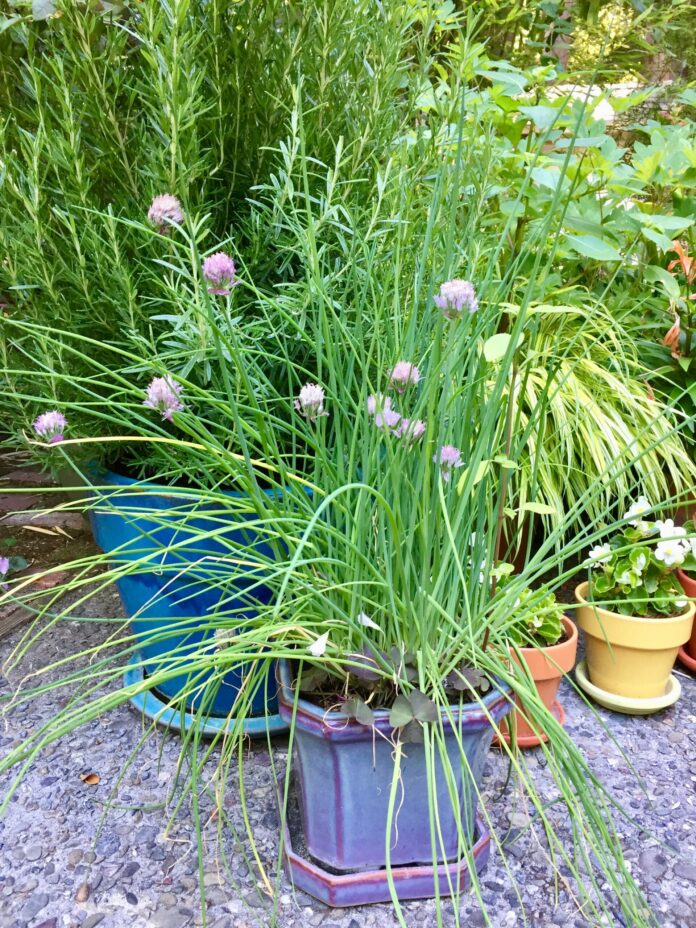Now that you have an assortment of herbs growing nicely in your garden what do you do with them? Mine seem to be growing more exuberantly than I anticipated and if I don’t keep up with snipping them often some will go to seed or get leggy and unproductive. Then what would I do when I’m putting together my favorite nectarine-caprese salad with fresh basil and mint leaves?
Most herbs should be harvested before the plants are about to bloom when leaves are at peak flavor and oils are strongest. Fresh leaves may be picked as soon as the plant has enough foliage to maintain growth. Harvest on a sunny morning after the dew has evaporated. To fully harvest annual herbs such as basil cut all stems back to just above the bottom two sets of leaves. Perennial herbs like sage should be cut back to about a third of their height just above a set of leaves. As you collect your harvest, keep them out of the sun or they will quickly wilt.
To store, wash herbs lightly with the leaves on the stems in cold running water to remove soil, dust or bugs, Drain on absorbent towels or hang plants upside down until the water evaporates. Then hang to dry thoroughly in small bunches in a dark, warm, well ventilated room. You can also lay them in a shallow basket or on a screen. if drying on a screen or basket remove large-leaved herbs from the stems before spreading them out. Smaller leaved herbs like thyme, savory or rosemary can be left on the stem to dry.
Herbs with a high moisture content, such as mint and basil, need rapid drying or they will mold. To retain some green leaf coloring, dry in the dark or by hanging plants upside down in bunches in paper bags.
Those herbs with a high water content like tarragon, basil, chives, lemon balm, mint and dill freeze well. Frozen herbs will keep their flavor for several months. Unlike dried herbs whose flavor is more concentrated when dried, frozen herbs can be used in the same proportion as fresh.
Herbs are dry when they crackle and crumble when rubbed between your fingers. Strip them from the stem and pack in labeled jars as they tend to look alike when dried. Crushing the leaves releases their essential oils so don’t do that until you use them.
Here are some herbs that do double duty in the garden:
- Basil- repels flies and mosquitos. Plant with tomatoes to improve flavor.
- Catnip- deters flea beetles, aphids, squash bugs, ants and weevils. Also repels mice.
- Chamomile-improves the flavor of cabbages, onions and cucumbers. Accumulates calcium, sulphur and potassium, returning them later to the soil. Also a host for beneficial hoverflies and good wasps and increases the productions of essential oils in herbs.
- Chives- improves growth and flavor of carrots and tomatoes. Keeps aphids away from mums and sunflowers. When planted by roses, helps prevent black spot.
- Coriander/cilantro- repels aphids, spider mites and potato beetle. Coriander tea is a good spray for spider mites.
- Dill- improves the growth and health of cabbage and lettuce. Plant by tomatoes to trap the tomato hornworm. Attracts many beneficials. Do not plant by caraway or carrots.
- Lemon balm- deters many bugs, especially mosquitos and squash bugs.
- Mint- deters cabbage moths, ants, rodents, aphids and fleas. Attracts hoverflies and predatory wasps. Attractive to earthworms.
- Rosemary- plant with cabbage, carrots, beans, and sage, Deters cabbage looper and bean beetles.
- Tarragon- beneficial to plants throughout the garden as is thyme.
- Jan Nelson, a landscape designer and California certified nursery professional, will answer questions about gardening in the Santa Cruz Mountains. E-mail her at ja******@*ol.com, or visit www.jannelsonlandscapedesign.com.












